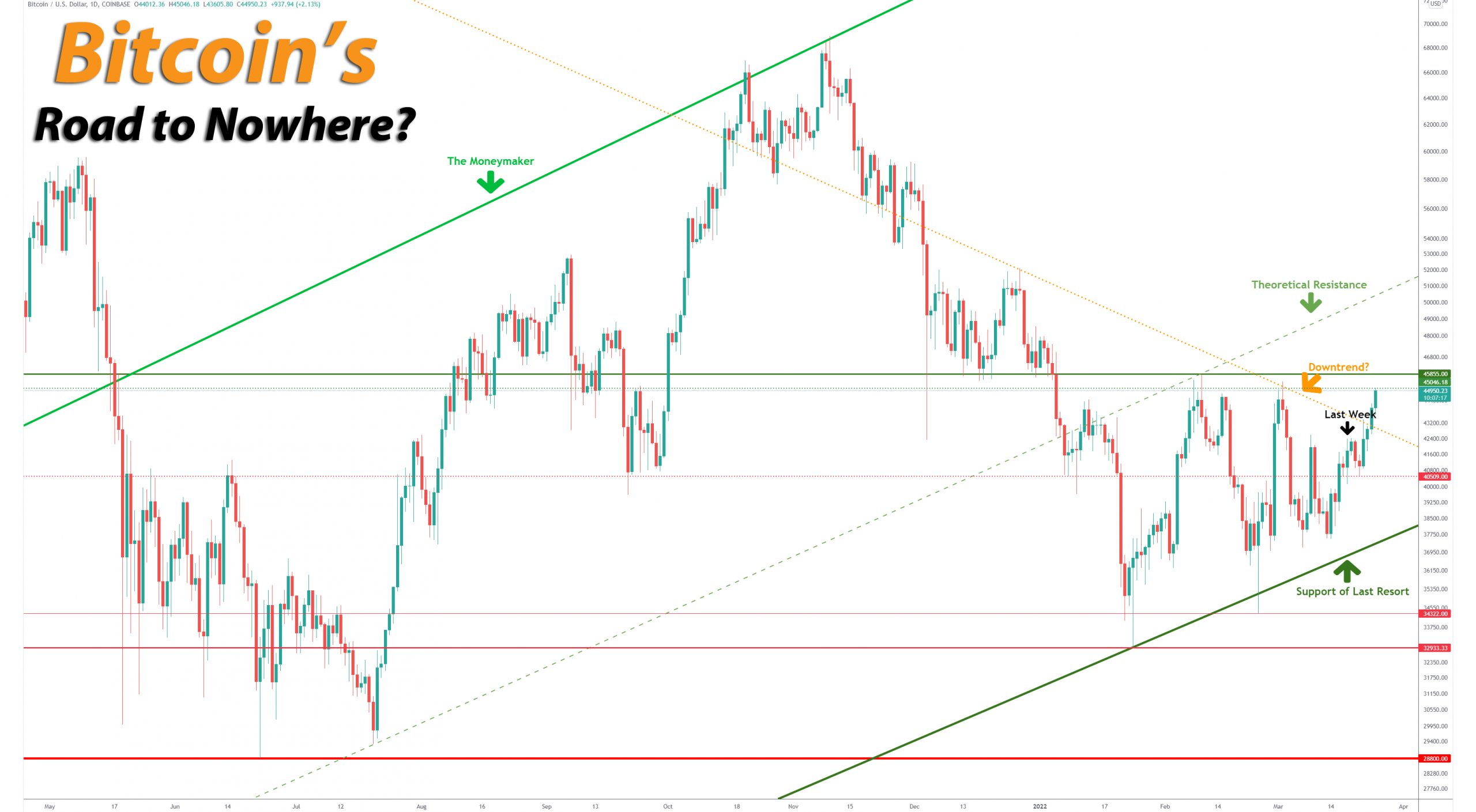Summing Up The Week
Despite continued volatility throughout the globe and the economy, the markets’ movements were relatively muted this week, all things considered.
Despite a huge bounce off the lows last week, the markets did not see a significant give-back of any kind this week. In fact, markets rose more than many pundits expected when taking in all the issues on the local and geopolitical stages.
Let’s take a look at the news that moved the markets…
Market News
Fed reiterates it will take “necessary steps” to fight inflation
Markets recoiled slightly on Monday following remarks from Fed Chairman Jerome Powell who reinforced commentary made last week that the Fed is prepared to do what is necessary to fight inflation, reported CNBC.
Despite comments following last week’s Fed rate hike, the market did not seem to take Powell seriously until he came out with additional commentary on Monday. “The labor market is very strong, and inflation is much too high; we will take the necessary steps to ensure a return to price stability,” said Powell while speaking at the National Association for Business Economics. “In particular, if we conclude that it is appropriate to move more aggressively by raising the federal funds rate by more than 25 basis points at a meeting or meetings, we will do so. And if we determine that we need to tighten beyond common measures of neutral and into a more restrictive stance, we will do that as well.”
While many pundits believe that the Fed will not be able to stem the rise of inflation – that the rate of inflation is already out-of-control – the Fed’s comments seemed to catch the markets off-guard as the indexes, which had been green up until that point, reversed their gains and finished the day lower.
U.S. sanctions 300 Russian elites, blocks central bank gold
On Thursday, the U.S. announced plans to sanction 400 Russian individuals and entities including more than 300 lawmakers, and the G-7 group of major economies including the European Union announced new measures to crack down on Russia including blocking its central bank’s access to gold reserves, reported CNBC.
In addition to additional sanctions against Russia, President Joe Biden announced a new set of American efforts to aid Ukraine, particularly more than $1 billion in additional humanitarian assistance for those affected.
While Russia and its richest citizens most certainly deserve sanctions and wealth confiscation, some pundits have raised concerns as to what actions taken by the U.S. and the rest of the world will mean to the state of the U.S. dollar as the world’s reserve currency.
Some of the questions raised include: Will sovereign nations still have confidence keeping their currency reserves in U.S. dollars if those reserves can be confiscated? Will foreign countries choose to keep their economies more centralized and limit globalization and global growth?
Between the COVID-19 revealing chinks in the global supply chain and Russia’s invasion of Ukraine, there will certainly be a lot of changes to come to how the international economies treat each other and their own country’s capabilities.
Next Week’s Gameplan
Now that the market has reached much higher levels off its lows, Buying Season has ended, for the moment, at least. As always, patience remains the name of the long-term investing game – develop a plan, wait patiently, and take action when the time comes, both on the downside and the upside.
In the meantime, I’ll see you all next week!
This Week in Play
Stay tuned for this week’s episodes of my two portfolios Investments in Play and Speculation in Play coming online later this weekend!
Crytpo Corner
Important Disclaimer
Get Irked contributors are not professional advisers. Discussions of positions should not be taken as recommendations to buy or sell. All investments carry risk and all readers must accept their own risks. Get Irked recommends anyone interested in investing or trading any asset class consult with a professional investment adviser to determine if an investment idea is suitable to them and their investment goals.Bitcoin Price (in USD)
%
Weekly Change
Bitcoin Price Action
The Bitcoin Bounce continues!
Bitcoin continued to rally this week, breaking through last week’s high to create a new point of resistance at $44,950.23 on Friday, however given the bullish nature of its current move, this resistance line might go even higher shortly.. Bitcoin made a very concerted and successful effort to break through the Downtrend? line on the macro timeline, although a lot of resistance remains above its current price.
From here, the next point of resistance is around $45,430, the high from Bitcoin’s last rally, followed by significant resistance at $45,855.00, its high of 2022, so far.
Additionally, Bitcoin created new support this week, too, with a higher weekly low set at $40,509.00. To the downside, key levels of support are around $37,000, its $34,322.00 low set in February, its 2022 low at $32,933.33 made in January, then $30K followed by its $28,800.00 low made in 2021.
The Bullish Case
Bulls see this higher-low, higher-high pattern as an indicator that the bottom is in, suggesting that Bitcoin is headed out of its “crypto winter” and into a new bull rally to all-time highs.
The Bearish Case
Bears concede that the Bulls have taken control on the shorter timeframes, however Bears still point to the longer timeframes and the macro picture, both of which present a lot of challenges to the Bull case heading forward. Only time will tell…
Bitcoin Trade Update
Current Allocation: 4.546% (-0.825% from last update)
Current Per-Coin Price: $41,525.45 (-0.242% from last update)
Current Profit/Loss Status: +8.247% (+10.634% from last update)
As always, long-time readers of the Crypto Corner will not be shocked to learn that I once again took profits when Bitcoin crossed over my per-coin price with a stop-sell order which filled on Friday morning at $43,770.20. The sale lowered my per-share cost just -0.242% from $41,626.30 to $41,525.45, but, more importantly, reduced my allocation -0.825% from 5.371% to 4.546%.
In the fast-moving world of crypto, I do not waste an opportunity to reduce my allocation size should any crypto spend much time consolidating above my per-coin cost.
Why always reduce allocation sizes even if the profits are relatively small?
Living through Bitcoin’s 80%+ selloff in 2018 taught me never to take support levels for granted in crypto (or any investment class, for that matter). When Bitcoin broke through $6K in November 2018, a level many Bitcoin Maximalists never thought would give way, it dropped nearly an additional –50% before finding support around $3,130!
Accordingly, whenever a crypto I trade starts a stabilizing pattern above my per-coin cost, I use stop orders to lock in gains and reduce allocation sizes just in case we see another dramatic selloff of 30-50% – a shockingly common occurrence in the space.
Bitcoin Buying Targets
Using Moving Averages and supporting trend-lines as guides, here is my plan for my next ten (10) buying quantities and prices:
0.063% @ $38,461
0.088% @ $37,584
0.117% @ $36,135
0.147% @ $34,383
0.759% @ $33,168
1.158% @ $31,857
2.023% @ $30,029
3.279% @ $27,689
4.314% @ $24,433
5.932% @ $22,280
No price target is unrealistic in the cryptocurrency space – Bullish or Bearish.
While traditional stock market investors and traders may think the price targets in the cryptocurrency space are outlandish due to the incredible spread (sometimes a drop of near -90% or a gain of up to +1000% or more), Bitcoin has demonstrated that, more than any speculative asset, its price is capable of doing anything. Here are some of Bitcoin’s price movements over the past couple of years:- In 2017, Bitcoin rose +2,707% from its January low of $734.64 to make an all-time high of $19,891.99 in December.
- Then, Bitcoin crashed nearly -85% from its high to a December 2018 low of $3128.89. In the first half of 2019, Bitcoin rallied +343% to $13,868.44.
- From June 2019, Bitcoin crashed -54% to a low of $6430.00 in December 2019.
- From December 2019’s low, Bitcoin rallied +64% to $10,522.51 in February 2020.
- In March 2020, Bitcoin crashed nearly -63% to a low of $3858.00, mostly in 24 hours.
- Then, Bitcoin rallied +988% to a new all-time high of $41,986.37 in January 2021.
- Later in January, Bitcoin dropped -32% to a low of $28,732.00.
- In February 2021, Bitcoin rallied +103% to a new all-time high of $58,367.00.
- Later in February, Bitcoin dropped -26% to a low of $43,016.00.
- In April 2021, Bitcoin rallied +51% to a new all-time high of $64,896.75.
- In June 2021, Bitcoin crashed -56% to a low of $28,800.00.
- In November 2021, Bitcoin rallied +140% to a new all-time high of $69,000.00.
- In January 2022, Bitcoin crashed -52% to a low of $32,933.33.
What if Bitcoin’s headed to zero?
The only reason I speculate in the cryptocurrency space is I truly believe Bitcoin isn’t headed to zero. I am prepared for that possibility, however, by knowing I could potentially lose all of the capital I’ve allocated to this speculative investment. Professional advisers recommend speculating with no more than 5% of an investor’s overall assets. Personally, I’ve allocated less than that to speculating in crypto. I feel that anyone who doesn’t fully believe in the long-term viability of cryptocurrency would be better served not speculating in the space. On a good day, this asset class isn’t suitable for those with weak stomachs. On volatile days, the sector can induce nausea in the most iron-willed speculator. If a speculator isn’t confident in the space, the moves will cause mistakes to be made.


